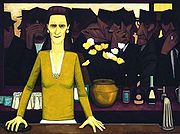
John Brack
Encyclopedia

Painting
Painting is the practice of applying paint, pigment, color or other medium to a surface . The application of the medium is commonly applied to the base with a brush but other objects can be used. In art, the term painting describes both the act and the result of the action. However, painting is...
, and a member of the Antipodeans group.
Life
John Brack was Art Master at Melbourne Grammar SchoolMelbourne Grammar School
Melbourne Grammar School is an independent, Anglican, day and boarding school predominantly for boys, located in South Yarra and Caulfield, suburbs of Melbourne, Victoria, Australia....
(1952–62). His art first achieved prominence in the 1950s. He also joined the Antipodeans Group
Antipodeans Group
-History:The Antipodeans group consisted of seven modern painters and the art historian Bernard Smith, who compiled The Antipodean Manifesto, a declaration fashioned from the artists' comments as a catalogue essay to accompany their exhibit....
in the 1950s which protested against abstract expressionism
Abstract expressionism
Abstract expressionism was an American post–World War II art movement. It was the first specifically American movement to achieve worldwide influence and put New York City at the center of the western art world, a role formerly filled by Paris...
. He was appointed Head of National Gallery of Victoria Art School
National Gallery of Victoria Art School
The National Gallery of Victoria Art School , associated with the National Gallery of Victoria, was founded in 1867. It was the leading centre for academic art training in Australia until about 1910. Among its luminaries, the school was headed by John Brack from 1962-68 and Sir William Dargie was...
(1962–68), where he was an influence on many artists and the creation of the expanded school attached to the new gallery building.
Style
Brack's early conventional style evolved into one of simplified, almost stark, shapes and areas of deliberately drab colour, often featuring large areas of brown. He made an initial mark in the 1950s with works on the contemporary Australian culture, such as the iconic Collins St., 5 pmCollins St., 5 pm
Collins St., 5 pm is a 1955 painting by Australian artist John Brack. The painting depicts office workers walking along busy Collins Street in Melbourne after finishing work for the day...
(1955), a view of rush hour in post-war Melbourne. Set in a bleak palette of browns and greys, it was a comment on the conformity of everyday life, with all figures looking almost identical. A related painting The Bar (1954) was modelled on Manet
Manet
-MANET as an abbreviation:*MANET is a mobile ad hoc network, a self-configuring mobile wireless network.*MANET database or Molecular Ancestry Network, bioinformatics database-People with the surname Manet:*Édouard Manet, a 19th-century French painter....
's A Bar at the Folies-Bergère
A Bar at the Folies-Bergère
A Bar at the Folies-Bergère , painted and exhibited at the Paris Salon in 1882, was the last major work by French painter Édouard Manet. It depicts a scene in the Folies Bergère nightclub in Paris...
, and satirised the Six o'clock swill
Six o'clock swill
The six o'clock swill was an Australian and New Zealand slang term for the last-minute rush to buy drinks at a hotel bar before it closed. During a significant part of the 20th century, most Australian and New Zealand hotels shut their public bars at 6 p.m. A culture developed of heavy drinking...
, a social ritual arising from the early closing of Australian bars. Most of these early paintings and drawings were unmistakably satirical comments against the Australian Dream
Australian Dream
The Australian Dream or Great Australian Dream is a belief that in Australia, home ownership can lead to a better life and is an expression of success and security...
, either being set in the newly expanding post-war suburbia or taking the life of those who lived there as their subject matter.
In the 1970s Brack produced a long series of highly stylised works featuring objects such as pencils in complex patterns. These were intended as allegories of contemporary life.
Period and themes

- War time drawings (1943–45)
- Scenes of urban life (Shops, street scenes etc.) (1952-
- Racecourse (1953–1956)
- School, the playground (1959–60)
- Wedding (1960–61)
- Shop Windows (1963–1977)
- Ballroom Dancers (1969)
- Gymnastics (1971–73)
- Postcards and implements (1976-
- Pencils and pens (1981-
- Mannequins (1989-
The catalogue of his work, and a year 2000 exhibition catalogue only cover the period to 1994.
Exhibitions and Auctions
A major retrospective exhibition of Brack's work opened at the National Portrait GalleryNational Portrait Gallery (Australia)
The National Portrait Gallery of Australia is a collection of portraits of prominent Australians that are important in their field of endeavour or whose life sets them apart as an individual of long-term public interest...
in Canberra on 24 August 2007, the last major exhibition for the gallery before its relocation. Brack's widow, Helen, attended the opening and commented that Brack was not concerned with the social standing of the sitter, but rather the artistic merit of their participation in the piece.
Brack's painting The bar sold for $3.2 million in April 2006, , while in May 2007 his painting The Old Time sold for $3.36 million at auction in Sydney, a record for a painting by an Australian artist .
- 2009 John Brack: Retrospective Exhibition, The Ian Potter Centre: NGV Australia
- 2006-2007 'The Nude in the Art of John Brack', MacClelland Gallery and Sculpture Park, Langwarrin
- 1999 'John Brack - Inside and Outside', works in the N.G.A. collection, National Gallery of AustraliaNational Gallery of AustraliaThe National Gallery of Australia is the national art gallery of Australia, holding more than 120,000 works of art. It was established in 1967 by the Australian government as a national public art gallery.- Establishment :...
, Canberra - 1998 'John Brack and Fred Williams', Art Gallery of South AustraliaArt Gallery of South AustraliaThe Art Gallery of South Australia , located on the cultural boulevard of North Terrace in Adelaide, is the premier visual arts museum in the Australian state of South Australia. It has a collection of over 35,000 works of art, making it, after the National Gallery of Victoria, the largest state...
, Adelaide - 1987-88 'John Brack - A Retrospective', National Gallery of Victoria, Melbourne
- 1981 'Drawings, 1945-79', Monash UniversityMonash UniversityMonash University is a public university based in Melbourne, Victoria. It was founded in 1958 and is the second oldest university in the state. Monash is a member of Australia's Group of Eight and the ASAIHL....
Gallery, Melbourne - 1977 'Paintings and Drawings, 1945-77', Australian National UniversityAustralian National UniversityThe Australian National University is a teaching and research university located in the Australian capital, Canberra.As of 2009, the ANU employs 3,945 administrative staff who teach approximately 10,000 undergraduates, and 7,500 postgraduate students...
- 1977 'Selected Paintings, 1947-77', Royal Melbourne Institute of TechnologyRMIT UniversityRMIT University is an Australian public university located in Melbourne, Victoria. It has two branches, referred to as RMIT University in Australia and RMIT International University in Vietnam....
Gallery, Melbourne
Further reading
- Ronald Millar, John Brack, (1971) Lansdowne Press Melbourne. ISBN 978-0-7018-0370-4.
External links
- Brack Retrospective at NGV May 2009 (Sunday Arts (ABC-TV) on Youtube
- John Brack in National Gallery of Australia
- http://www.balgal.com/?id=brackjohnThe Sewing Machine 1955 at Ballarat Fine Art GalleryBallarat Fine Art GalleryArt Gallery of Ballarat is the oldest and largest regional art gallery in Australia. Established in 1884 as the Ballarat Fine Art Gallery by the citizens of Ballarat both the building and part of its collection is listed on the Victorian Heritage Registerand by the National Trust of Victoria.The...
.] - John Brack at OnlyMelbourne
- Images of John Brack's prints at Prints and Printmaking .

